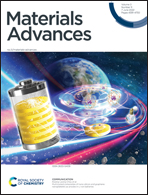2D GeP3 and blue P: promising thermoelectric materials for room- and high-temperature applications†
Abstract
Thermoelectric materials have attracted great attention from the research community due to their capability to convert heat into electricity. Among these materials, two-dimensional (2D) systems are potential candidates for thermoelectric applications due to their unique electronic, mechanical and optical properties. In this work, we combine Density Functional Theory and Boltzmann Transport Equation (BTE) calculations to investigate the performance of 2D hexagonal Germanene (Ge), blue Phosphorene (blue P) and GeP3 as thermoelectric materials. The Seebeck (S), electric conductivity (σ) and thermal electronic conductivity (κe) are obtained with the SIESTA and BoltzTraP codes by means of a module especially developed for this aim in combination with the Spglib library, while the lattice thermal conductivity (κ ) is obtained with the phono3py code. The studied materials have charge carrier concentrations close to 1018 cm−2, and blue P displays the largest electric figure of merit (ZTe ∼ 1.0), followed by GeP3 and Ge. Regarding the maximum ZTe for each of the investigated materials, we find that blue P has a central peak with ZT(blueP)e = 1.0 at T = 800 K, Germanene has a pronounced peak with ZT(Ge)e = 0.45 at T = 340 K and GeP3 has two such peaks, with
) is obtained with the phono3py code. The studied materials have charge carrier concentrations close to 1018 cm−2, and blue P displays the largest electric figure of merit (ZTe ∼ 1.0), followed by GeP3 and Ge. Regarding the maximum ZTe for each of the investigated materials, we find that blue P has a central peak with ZT(blueP)e = 1.0 at T = 800 K, Germanene has a pronounced peak with ZT(Ge)e = 0.45 at T = 340 K and GeP3 has two such peaks, with  and 0.98 at T = 300 K and T = 10 K, respectively. For all three compounds, κ
and 0.98 at T = 300 K and T = 10 K, respectively. For all three compounds, κ (T) in the range T = 200–700 K decreases monotonically with increasing T, with ratios
(T) in the range T = 200–700 K decreases monotonically with increasing T, with ratios  and
and  , indicating that the electronic contributions to ZTGeP3 establish its upper bound. Our findings suggest that GeP3 can be a promising room-temperature thermoelectric material if further tailoring of its electronic properties allow for an increase in ZTe.
, indicating that the electronic contributions to ZTGeP3 establish its upper bound. Our findings suggest that GeP3 can be a promising room-temperature thermoelectric material if further tailoring of its electronic properties allow for an increase in ZTe.



 Please wait while we load your content...
Please wait while we load your content...